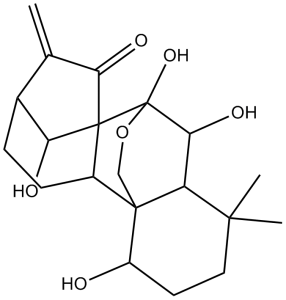Oridonin (NSC-250682)
This product is for research use only, not for human use. We do not sell to patients.

For small sizes, please check our retail website as below: www.invivochem.com
| Size | Price | Stock |
|---|---|---|
| 500mg | $450 | Check With Us |
| 1g | $700 | Check With Us |
| 5g | $1770 | Check With Us |
Cat #: V1990 CAS #: 28957-04-2 Purity ≥ 98%
Description: Oridonin (NSC-250682; Isodonol) is a novel, naturally occurring and cell-permeable diterpenoid extracted from Rabdosia rubescens with anticancer activity.
Top Publications Citing Invivochem Products
Publications Citing InvivoChem Products
Product Promise

- Physicochemical and Storage Information
- Protocol
- Related Biological Data
- Stock Solution Preparation
- Quality Control Documentation
| Molecular Weight (MW) | 364.43 |
|---|---|
| Molecular Formula | C20H28O6 |
| CAS No. | 28957-04-2 |
| Storage | -20℃ for 3 years in powder formr |
| -80℃ for 2 years in solvent | |
| Solubility In Vitro | DMSO: > 10 mMr |
| Water: N/Ar | |
| Ethanol: N/A | |
| SMILES Code | C=C([C@H](CC1)[C@H]2O)C([C@@]32[C@]4(O)[C@@H](O)[C@]5([H])C(C)(C)CC[C@H](O)[C@@]5(CO4)[C@@]31[H])=O |
| Synonyms | NSC250682; Isodonol; NSC-250682; NSC 250682; Oridonine |
| Protocol | In Vitro | Oridonin is an ATP-competitive inhibitor of AKT with IC50s of 8.4 and 8.9 μM for AKT1 and AKT2, respectively. Oridonin (5, 10 or 20 μM) obviously inhibits the growth of KYSE70, KYSE410 and KYSE450 ESCC cells via targeting AKT1/2. Oridonin (10 or 20 μM) causes G2/M phase cell cycle arrest in KYSE70, KYSE410 and KYSE450 cells, and induces apoptosis in these three cell lines at 20 μM. In addition, Oridonin (5, 10 or 20 μM) in combination with cisplatin or 5-FU enhances the inhibition of esophageal squamous cell carcinoma (ESCC) cell growth. |
|---|---|---|
| In Vivo | Oridonin (160 mg/kg, p.o.) shows significant reduction in the tumor growth without obvious weigh loss in SCID mice bearing EG9 and HEG18 tumor cells. Oridonin treatment also suppresses the expression of Ki-67, phosphorylated AKT, GSK-3β or mTOR in mice. |
These protocols are for reference only. InvivoChem does not
independently validate these methods.
| Solvent volume to be added | Mass (the weight of a compound) | |||
|---|---|---|---|---|
| Mother liquor concentration | 1mg | 5mg | 10mg | 20mg |
| 1mM | 2.7440 mL | 13.7201 mL | 27.4401 mL | 54.8802 mL |
| 5mM | 0.5488 mL | 2.7440 mL | 5.4880 mL | 10.9760 mL |
| 10mM | 0.2744 mL | 1.3720 mL | 2.7440 mL | 5.4880 mL |
| 20mM | 0.1372 mL | 0.6860 mL | 1.3720 mL | 2.7440 mL |
The molarity calculator equation
Mass(g) = Concentration(mol/L) × Volume(L) × Molecular Weight(g/mol)
Mass
=
Concentration
×
Volume
×
Molecular Weight*
The dilution calculator equation
Concentration(start)
×
Volume(start)
=
Concentration(final)
×
Volume(final)
This equation is commonly abbreviated as: C1 V1 = C2 V2
Concentration(start)
C1
×
Volume(start)
V1
=
Concentration(final)
C2
×
Volume(final)
V2
Step One: Enter information below
Dosage mg/kg
Average weight of animals g
Dosing volume per animal µL
Number of animals
Step Two: Enter the in vivo formulation
%DMSO
+
%
+
%Tween 80
+
%ddH2O
Calculation Results:
Working concentration:
mg/ml;
Method for preparing DMSO master liquid:
mg
drug pre-dissolved in
µL
DMSO(Master liquid concentration
mg/mL)
,Please contact us first if the concentration exceeds the DMSO solubility of the batch of drug.
Method for preparing in vivo formulation:
Take
µL
DMSO master liquid, next add
µL
PEG300, mix and clarify, next add
µL
Tween 80,mix and clarify, next add
µL
ddH2O,mix and clarify.
Note:
- (1) Please be sure that the solution is clear before the addition of next solvent. Dissolution methods like vortex, ultrasound or warming and heat may be used to aid dissolving.
- (2) Be sure to add the solvent(s) in order.




































